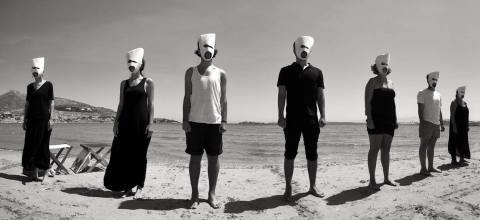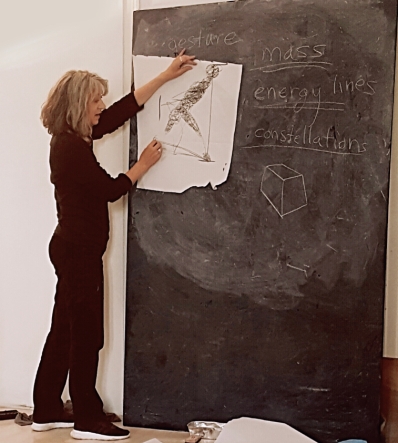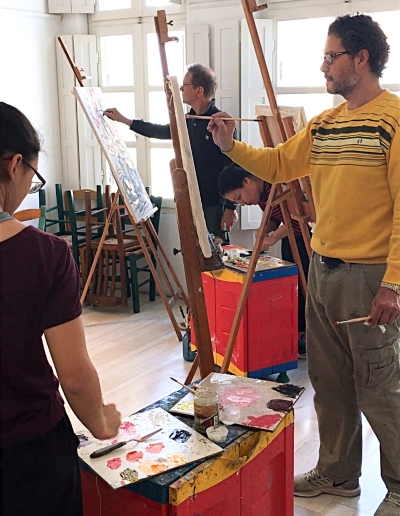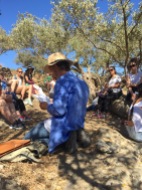Half Way
29, October 2016 § Leave a comment
 Clearing Storm at the end of a brilliant day
Clearing Storm at the end of a brilliant day
As the last days of October come in with clouds and cold winds, we have arrived at our half term break. Some of the students will be travelling, but the majority of the group are choosing to stay in Paros to work in the studios and the digital lab. It has been a busy and event filled semester. After returning from Italy we introduced the landscape of our lovely island with several hikes, the first was a walk above Lefkes to the inner valley beyond the windmills. There among the olive trees John read an entry from his journal from the time he lived on the Navajo Reservation in Arizona. It never fails to move his audience and this time there was a deep quiet as he finished. His words touched us all.
 John reading from his journal under the olive trees
John reading from his journal under the olive trees
Last weekend we sailed around Antiparos with Captain Tasso and had a meal at Zombos, a restaurant at the southern end of the island facing Despotico. We had just strolled about the new excavations of the ancient temple, getting a glimpse into the working of the restorers who are rebuilding the facade of the temple. The winds came up as we finished our meal and Captain Tasso felt we needed to start back to avoid the oncoming storm. It caught up with us anyway and we all got wet, but the students sang and huddle together and we were rewarded with a full rainbow as we turned the corner toward Paros and home.
A few days ago Dimitra Skandalis gave a guest lecture on her work just before she returned to her new home in San Francisco. She shared her ideas and her passions with students and brought along some samples of the work she does with seaweed. She is a former student who is originally from Paros. Her exhibition at the school this summer was her first solo show here on the island.
Now with a much needed break to consolidate information and clarify goals, the students will come back to finish the semester work and prepare to display their efforts for the final exhibition in the first week of December.
 Cliffs of volcanic detritus on the backside of Antiparos.
Cliffs of volcanic detritus on the backside of Antiparos.
 Enjoying the Rain…Hoddies!
Enjoying the Rain…Hoddies!
:Thanks, Ken Shiozawa, for the photos and being Student Extraordinaire
Annelise Grindheim’s Drama
10, July 2016 § 1 Comment
by: Jeffrey Carson
The origins of drama are mysterious. But my intuition suggests that all drama starts in awe of the world, its powers and unseen powers, its passions and irresolutions. Drama has its roots in religion, cult, magic, poetic rapture, birth/sex/death, and natural wonder. I think this is true of anonymous Passion plays from the Middle Ages, Shakespeare’s investigations of everything human and beyond, ghostly Japanese Noh, rollicking Restoration comedy, throbbing opera, and even the great realist works of the last century-and-a-half, whose master is Henrik Ibsen.
I did not mention ancient Greek plays because these astonishing works – we have thirty-two of them – seem to know this about themselves, and consciously embed themselves in primitive ritual and, with music and poetry, political realism.
The Aegean Center’s drama teacher, Anneliese Grindheim, knows these things, and her love and understanding of the Greek plays informs her work here on Paros. Last autumn she produced a condensed version of Lorca’s frightening tragedy, “The House of Bernarda Alba”, which, in image-loaded verse, shows what happens when society’s rules try to squelch the natural joy and passion of life. Working with small forces – students and a few local friends – Annelise trimmed the work to its essentials – she has an amazing ability to do this with respect and accuracy.

Annalise Grindheim
This spring’s work was even more ambitious. It was Ibsen’s “Lady from the Sea”, a realist drama. Redacting again, Annelise found the poetry and intensity curled deep in the Norwegian master’s realism (she is Norwegian herself). The play is a liminal work, and we are never sure what will happen as the symbols keep being transformed. The actors performed it on the beach, sometimes on sand, sometimes in water. The growth of the heroine’s soul and self into maturity, and its salutary effect on her husband, were aided by movements derived from dance, by declamation derived from poetry, by masks, and by the sea itself – wavelets, gulls, breezes, briny clarity. Liminal indeed.
I’m fortunate to work at the Aegean Center with such skilled practitioners of their arts as John Pack, Jane Pack, Jun-Pierre Shiozawa, and most recently, Annelise Grindheim. What will she come up with next? I may write a poem about it.
Clean Monday / Καθαρά Δευτέρα
14, March 2016 § 1 Comment
Clean Monday, Καθαρά Δευτέρα, is celebrated today here in Greece. It is the first day of Lent when the faithful begin 40 days of fasting in preparation for Easter.
Traditional foods are served which emphasis austerity and deprivation to echo the fasting of Christ in the desert. In Paros the devout eat pickles, food without oil, and animal flesh only without blood such as kalimari and octopus. Eggs, dairy and meat are absent from the table. These rules make sense for an agricultural society which must protect the brooding chickens and the young goats and cows so as to assure the next generation. There will be kite flying and family picnics if the weather is good, being out of doors allows us to witness a burgeoning spring with the world returning to abundance and production after the winter’s hush. Here on the island we have a winter that is most gentle and verdant, the deprivations others face with cold and snow are less known to us. We watch the re-emergence of new leaves on the deciduous trees resembling butterflies emerging from their chrysalis. We observe the prancing young goats and lambs. We contemplate the new growth which is all around making us aware of the cycles of nature, potent harbingers of life and rebirth.

“Lagana / Λαγάνα” the special azyme bread baked only on Clean Monday.
Greeks are asked to give up luxuries during this time. Many people no longer conform to the strict diets but I feel there is something important about denying ourselves our indulgences. We grow accustomed to having far more than is necessary for our existence. Every year I try to find something which I think I need but which is not essential to my survival and give it up for 40 days. I have denied myself at various times chocolate, coffee, wine and sweets. None of these posed a particular problem for me. Far more difficult was the challenge to give up complaining which I did not manage. This year I have decided to quit looking at the daily news feed in the mornings. I find it wastes at least one to two hours of time that I would otherwise fill with more imaginative pursuits. Beginning every morning with the anxious headlines is addictive but not ultimately uplifting or productive. Perhaps I will simply sit with my coffee and dream, with luck I will begin a creative project. And so my yearly fast begins.
The Fall 2013 Student Exhibition
4, December 2013 § Leave a comment
THE AEGEAN CENTER FOR THE FINE ARTS PRESENTS ITS WINTER VOCAL CONCERTS
4, December 2012 § Leave a comment
The Sanctum
15, October 2012 § Leave a comment
At the core of the Aegean Center, lies the philosophy of the Sanctum, the Center’s special space for students in the hill village of Lefkes. If the Center is an oasis for the Classical arts in a wasteland of post-modernism, then the Sanctum is an island refuge from the din of the over-connected, banal networks found in the supposed modern world. In my own experience I have found the Sanctum to be a place of healing, a fountain of renewal after I had been drained dry by societies pressures and the indecision of identity and character.
In 2010 I was still connected to old rhythms, still dancing a tired, limping waltz leftover from an exhausting home-care commitment in which I had willingly labored since 2004 and human aid work in Bosnia in 2007 and 2008. That fresh spring day I had not intended to come to sit in the clear light of that quiet room. I had wandered around Lefkes hoping to take some interesting photos in the streets and the surrounding area, but found myself, quite by accident, at the Sanctum’s door. The students had visited the place a few weeks before with John Pack. He had told us something about himself that day and opened up his heart in both joy and sadness. I inserted my shiny, new key, turned the lock and walked in. I put down my day-pack. It suddenly felt too heavy to bear. The muted April light shining through the windows illuminated the soft pillows, colorful rugs and a small wooden writing desk on the floor. There were only earth tones, nothing jarring to the senses. There was a painting on the wall, some wooden tables, a few simple caned chairs. The air was cool, scented with oregano growing in small pots. In comparison I felt heavy, ungainly, somewhat unbalanced. My mind was buzzing with a dull grey drone and I found myself asking questions as old as Paros: “Why am I here? Who am I? What is my reason? Where am I going? What will I find when I get there?” I sat down roughly into the pillows, grateful for their softness, kicked off my shoes and fell into oblivion.
I awoke an hour later feeling more calm, but still pensive. I had dreamed. I understood that it was acceptable to feel uncertain, to ask these questions of myself. I didn’t need the answers today. Perhaps they would never be satisfied. To keep searching would be better than ending the quest with a quick, efficient, modern answer. I had discovered this vital truth, a truth I knew in my heart, in a little room in Greece, surrounded by silence and light. I returned to Paroikia that afternoon, transformed.
So what is the philosophy of the Sanctum? To be honest I am not entirely sure, but I know that there is one important rule: No electronic interference or devices: no mobile phones, no internet, no recorded music, no games. Nothing that would distract the mind from the important experience of ‘being’, as opposed to ‘doing’. We come to the Sanctum to learn who we are, just as we come to the Aegean Center to experience something we do not have in America, or wherever we are from. With any luck we leave that behind when we step off the boat from Athens. We search for something more meaningful in a world measured by ‘things’ and a vertical technology. We disengage from the cacophony of an incorrectly defined progressive era, step over the marble threshold and into a clear and quiet room. We put down what we carry.
– John D.C. Masters, Paros, 15 October, 2012
Some Advice and a Song from Michael Butler
23, April 2012 § Leave a comment
Michael Butler, curator of the Sidney Cooper Gallery at Canterbury Christ Church College in Canterbury, England recently visited Greece and dropped by the Aegean Center. Traveling with his wife, Claire, they felt the need for some sunshine and came to renew their acquaintance with the landscape which Michael had backpacked through many years ago. Michael was introduced to John Pack when the exhibit, The Greater Journey, with John’s photographs and poetry by Peter Abbs, was hosted by the Sidney Cooper Gallery in 2008.
We urged Michael to give us a short talk on whatever topic he wished. We were treated to an abbreviated summary of his career choices (as a youth he sang with Benjamin Britten), an inventory of suggestions for artists when approaching a gallery, and a lovely song which he adapted from Purcell’s Fairest Isle and to which he wrote new words reflecting his Paros stay. He sang this a cappella in a lovely high baritone. We include his lyrics here:
To Paros
Fairest Isle
All dreams excelling
Source of beauties
And of love.
*
The Gods’ own blessings
Fell upon it
Crowned with glories
Wreathed in light.
*
Artemis and Apollo’s
Temples
Marbled Halls
With statues bold.
*
Speak of times where
Man’s invention
Chimed in union
With this world.
His best advice: your CV is not a list of what you have done but an invitation to live fully and fill in the blank spaces as you go.
Thank you, Mike.
– Jane Pack
Aegean Center Thyme Flop
15, February 2012 § Leave a comment















